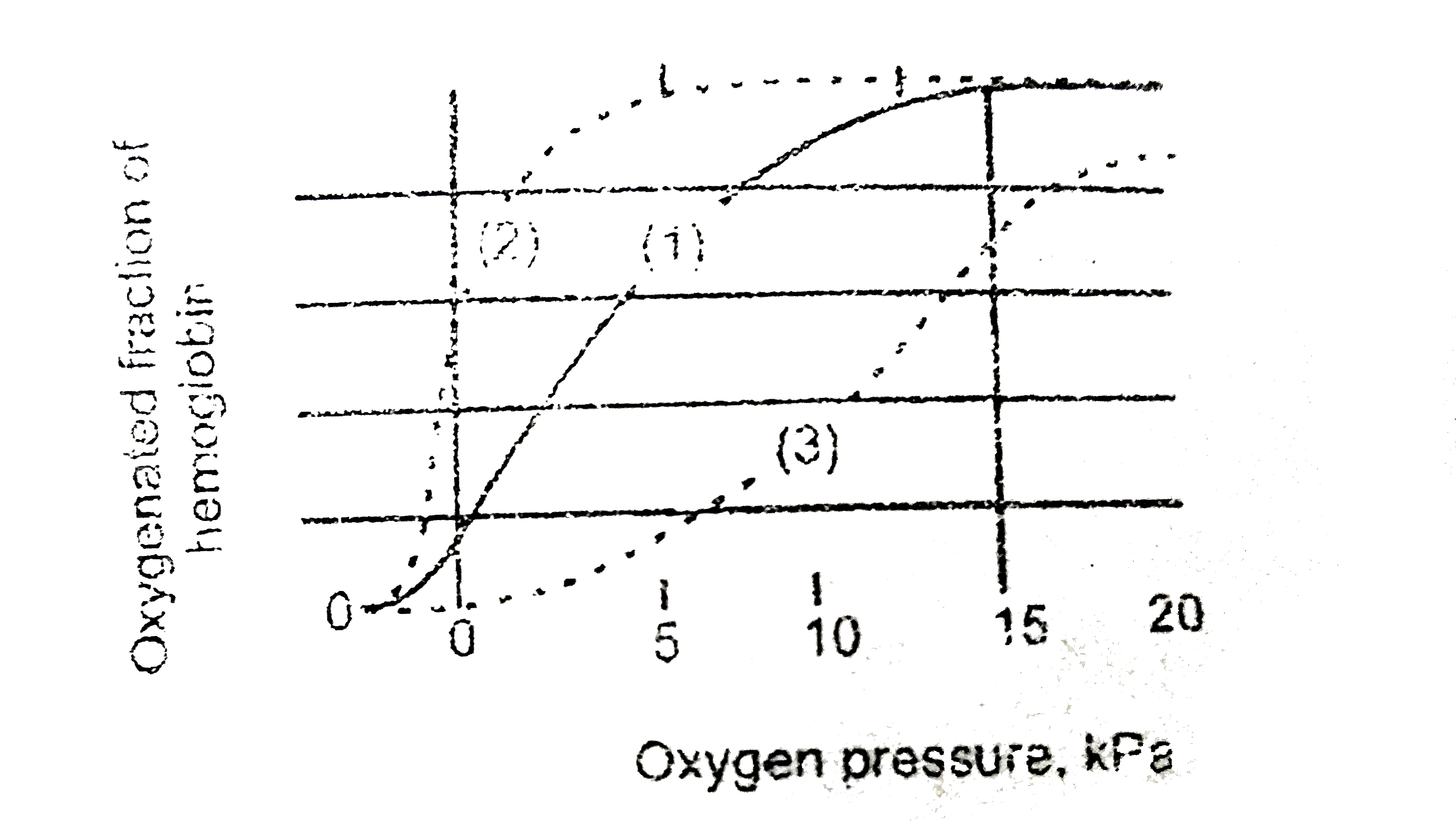Oxygen is of vital importance for all of us . Oxygen enters the body via the lungs and is transported to the tissues in our body by blood . There it can deliver energy by the oxidation of sugars.
C6H12O6+6O2→6CO2+6H2O
This reaction releases 400 KJ of energy per mole of oxygen O2 uptake by blood is at four heme (Hm) group in this protein hemoglobin (Hb).
Free Hm consists of an Fe2+ giving HmO2 complex. Carbon monoxides can be complexed similarily giving a Hm CO complex . CO is poison as it bonds more strongly to Hm than O2 does. The equilibrium constant Kf for the reaction:
Hm+CO⇔HCO ........(i)
is 1000 times larger than the equilibrium constant K2 for the reaction:
Hm+CO2⇔HmO2 ........(ii)
Each Hb molecules can take up four molecules of O2 absorbs a fraction of this amount, depending on the oxygen pressure , as shown in figure1 (curve 1) . Also shown are the curve (2) and (3) for blood with two kinds of dificient Hb . These occur in patients with certain hereditary diseases.

Relevant data , O2 pressure in lungs is 15 KPa , in the muscles it is 2KPa . The maximum flow of blood through heart and lungs is 4×10−4m−3s−1 . The red cells in blood occupy 40% of the volume, inside the cells the concentration of Hb has a molar mass of 64 kg mol−1 R=8.314 Jmol−1K−1 , T=298k . Using the relation between K and the standard Gibbs energy ΔG∘ for a reaction, calculated the difference between the ΔG∘ values for the home reactions (i) and (ii).
The correct Answer is:ΔG∘1=−RTInK1 ΔG∘2=−RTInK2
ΔG∘2−ΔG∘1=ΔG∘1=RTInK1K2
ΔG∘2−ΔG∘1=(8.314Jmol−1K−1×298k×In10000)J=23KJmol−1
Step by step video & image solution for Oxygen is of vital importance for all of us . Oxygen enters the body via the lungs and is transported to the tissues in our body by blood . There it can deliver energy by the oxidation of sugars. C_(6)H_(12)O_(6) + 6O_(2) rarr 6CO_(2) + 6H_(2)O This reaction releases 400 KJ of energy per mole of oxygen O_(2) uptake by blood is at four heme (Hm) group in this protein hemoglobin (Hb). Free Hm consists of an Fe^(2+) giving HmO_(2) complex. Carbon monoxides can be complexed similarily giving a Hm CO complex . CO is poison as it bonds more strongly to Hm than O_(2) does. The equilibrium constant K_(f) for the reaction: Hm+ CO hArr HCO " "........(i) is 1000 times larger than the equilibrium constant K_(2) for the reaction: Hm + CO_(2) hArr HmO_(2)" " ........(ii) Each Hb molecules can take up four molecules of O_(2) absorbs a fraction of this amount, depending on the oxygen pressure , as shown in figure1 (curve 1) . Also shown are the curve (2) and (3) for blood with two kinds of dificient Hb . These occur in patients with certain hereditary diseases. Relevant data , O_(2) pressure in lungs is 15 KPa , in the muscles it is 2KPa . The maximum flow of blood through heart and lungs is 4 xx 10^(-4)m^(-3)s^(-1) . The red cells in blood occupy 40% of the volume, inside the cells the concentration of Hb has a molar mass of 64 kg "mol"^(-1) R=8.314 J "mol"^(-1) K^(-1) , T=298k . Using the relation between K and the standard Gibbs energy DeltaG^(@) for a reaction, calculated the difference between the DeltaG^(@) values for the home reactions (i) and (ii). by Chemistry experts to help you in doubts & scoring excellent marks in Class 12 exams.
Updated on:21/07/2023Topper's Solved these Questions
Similar Questions
Knowledge Check
Refer the given equation.
2(C51H98O6)+145O2→102CO2+98H2O+ Energy The RQ in this case isA1B0.7C1.45D1.62
Find out the calorific value of Glucose C6H12O6+6O2→6CO2+6H2O,ΔH=−2900 kJ/mole
View SolutionRefer the given equation.
2(C51H98O6)+145O2→102CO2+98H2O+ Energy The RQ in this case is
View SolutionThe inversion of cane sugar is represented by
C12H22O11+H2O→C6H12O6+C6H12O6
It is a reaction of
View SolutionThe reaction
5H2O2+XClO2+2OH−→XCl−+YO2+6H2O
is balanced if
View Solution2Ag++C6H12O6+H2O→2Ag(s)+C6H12O7+2H+ Find ln K of this reaction.
View SolutionDuring the reaction C6H12O6+6O2→6CO2+6H2O which compound is reduced ?
View SolutionThe inversion of cane sugar is represented by: C12H22O11+H2O→C6H12O6+C6H12O6 It is a reaction of :
View Solution
